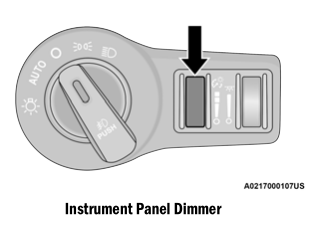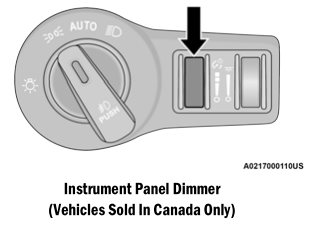Dodge Charger: INTERIOR LIGHTS / Dimmer Controls
The brightness of the instrument panel lighting and lighted cupholders (if equipped) can be regulated by rotating the left dimmer control up (brighter) or down (dimmer). When the headlights are on you can supplement the brightness of the instrument cluster display, radio and overhead console by rotating the control to the first detent up until you hear a click. This feature is called “Parade” mode and is useful when headlights are required during the day. Rotating the dimmer control up to the second detent, the furthest position up, turns on the courtesy lights. This feature is known as “Dome On”.


 Ambient Light — If Equipped
Ambient Light — If Equipped
The overhead console is equipped with an ambient light feature. This light illuminates
for improved visibility of the floor and center console area.
Rotate the right dimmer control upward or downward to increase or decrease the
brightness of the door handle lights, map pocket lights, and ambient light located
in the overhead console...
 WINDSHIELD WIPERS AND WASHERS
WINDSHIELD WIPERS AND WASHERS
The windshield wiper/washer controls are located on the multifunction lever on
the left side of the steering column. The front wipers are operated by rotating
a switch, located on the end of the lever...
Other information:
Dodge Charger 2011-2025 Owner's Manual: Lap/Shoulder Belt Operating Instructions
Enter the vehicle and close the door. Sit back and adjust the seat. The seat belt latch plate is above the back of the front seat, and next to your arm in the rear seat (for vehicles equipped with a rear seat). Grab the latch plate and pull out the seat belt...
Dodge Charger 2011-2025 Owner's Manual: Leather Surfaces
Mopar® Total Clean is specifically recommended for leather upholstery. Your leather upholstery can be best preserved by regular cleaning with a damp soft cloth. Small particles of dirt can act as an abrasive and damage the leather upholstery and should be removed promptly with a damp cloth...
Categories
- Manuals Home
- Dodge Charger Owners Manual
- Dodge Charger Service Manual
- Keyless Enter-N-Go — Passive Entry
- To Lock/Unlock The Doors And Trunk
- High/Low Beam Switch, Automatic High Beam — If Equipped
- New on site
- Most important about car
Manual Door Locks
The power door locks can be manually locked from inside the vehicle by using the door lock knob. To lock each door, push the door lock knob on each door trim panel downward. To unlock the front doors, pull the inside door handle to the first detent. To unlock the rear doors, pull the door lock knob on the door trim panel upward. If the lock knob is down when the door is closed, the door will lock.
